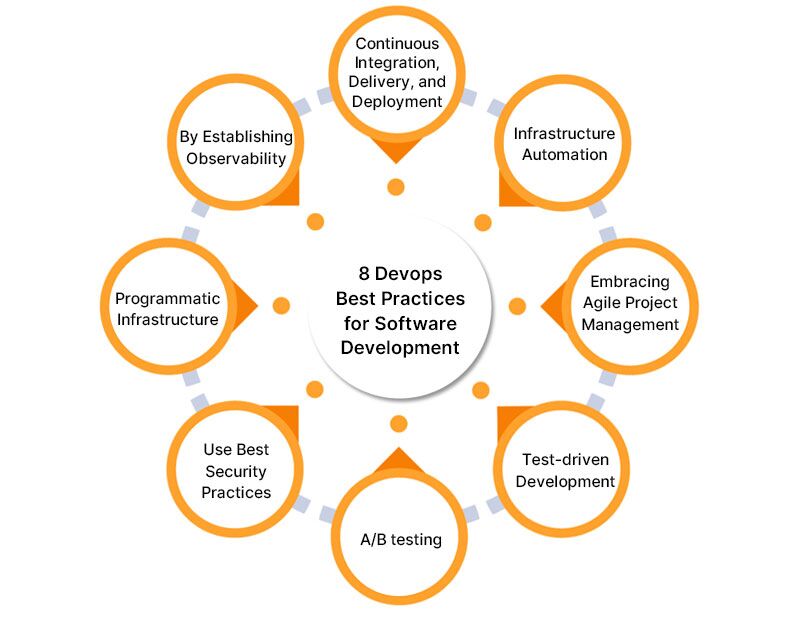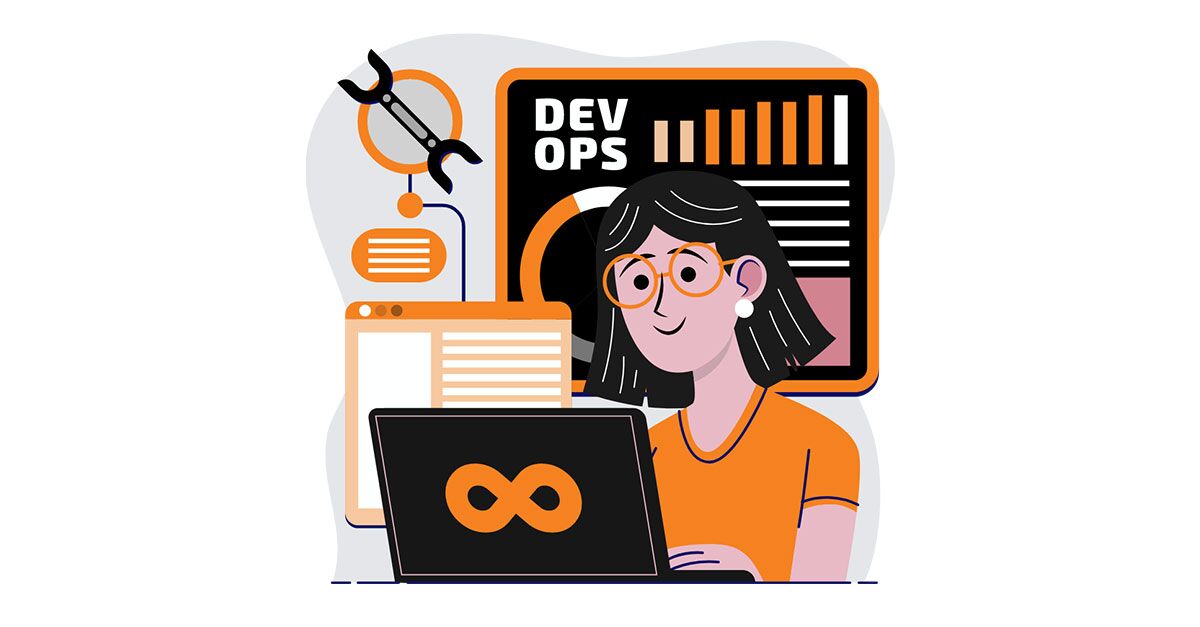DevOps brings development and operations teams together to improve collaboration, communication, and the overall speed and quality of software delivery. For enterprises, implementing DevOps best practices can be challenging, but it can significantly improve efficiency, productivity, and competitiveness. And by following some of the top practices, you can increase the potential of DevOps with DevOps development services, in tow.
So, in this blog, we will explore some of the best practices for implementing DevOps in an enterprise environment.
8 DevOps Best Practices For Software Development

1. Continuous integration, delivery, and deployment
Continuous integration, delivery, and deployment (CI/CD) is the practice of merging all developer working copies to a shared mainline several times a day. It is a software engineering approach in which teams produce software in short cycles, ensuring that code can be reliably released at any time.
The most common CI/CD tools are:
- Gitlab CI for continuous integration (CI)
- Travis CI for continuous delivery.
An excellent way to get started with CI/CD is by using Jenkins as your build server; Jenkins has many plugins that enable it to manage different phases of an application lifecycle, like testing or deployment.
2. Infrastructure automation
Infrastructure automation is the process of automating the provisioning, deployment, configuration, management, monitoring, and re-purposing of computer hardware (servers) and software (applications). This includes both physical and virtual environments.
Docker containers are a great way to automate tasks like installing software on a server or updating its operating system without having to install it over and over again manually. You can also use Ansible roles for this purpose as well.
3. Embracing agile project management
Agile project management is a way of managing a project that focuses on delivering working software in short cycles, called sprints.
Agile project management helps the team to respond to change quickly. It encourages collaboration between developers and QA, who test the software as it develops. Agile projects can be completed in two weeks or less if done right!.
[Also Read: CTO’s Guide to Agile Software Development Life Cycle]
4. Test-driven development
Test-driven development is a process that focuses on writing tests before you write the code. This helps ensure that your code works as expected and allows you to ensure that each feature of your product or service is being implemented correctly.
Test-driven development can be used in any type of project: from simple small programs to large applications with many developers working on them at once.
5. A/B testing
A/B testing is a technique for testing two versions of your site or product. You do this by showing different audiences a different version and then seeing which gets more users. This can be used for everything from email newsletters to landing pages and even internal systems, like the code that runs on your servers.
The Benefits of doing A/B testing:
- Improved conversion rates – If you know which version of your site or product generates better results, you can use that version instead of the other one whenever possible. This saves resources because they need to be spent on improving something that isn’t working well enough yet (or worse, spending them on all the things that aren’t working).
- Increased engagement – When people see something new in front of them, they’re naturally curious about what it will do next and how it works—especially when it comes from someone unfamiliar with their context (like an entrepreneur trying out new ideas). Suppose this curiosity leads someone to engage further with your brand or business model (such as clicking through an article). In that case, there’s no better feeling than having a 100% success rate in converting those readers into customers!
6. Use best security practices
Use a centralized logging solution to collect real-time data from your infrastructure and applications for later analysis by IT staff or security analysts.
Use a centralized monitoring solution for application performance monitoring (APM), system monitoring, log management, etc., to gain visibility into what’s happening across all your systems at any given time, even if they are running different operating systems or languages. This will help identify potential vulnerabilities before they become costly incidents later down the road when it comes time to patch them up again!
7. Programmatic infrastructure
Programmatic infrastructure is a way to automate the creation, deployment, and management of infrastructure as code. It defines your infrastructure as code so you can quickly replicate it in different environments. Programmatic infrastructure is also helpful for deploying applications across multiple cloud providers.
To use programmatic infrastructure effectively, it’s essential to understand what type of applications are being used in your organization and how they interact with each other or other parts of your business—because these interactions affect what type of configuration needs to be defined in order to deploy an application successfully on any given platform (for example Amazon Web Services).
8. By establishing observability
As a CTO, you’re probably familiar with the concept of monitoring and observability. These terms refer to keeping an eye on your applications so you can spot problems before they become significant issues.
Monitoring is when a system sends its data back to itself (the monitoring system) and logs each change to analyze it later. Observability refers to how easily someone from outside the company can see what’s happening within an application or service. This makes it easier for them to understand why certain things happen at certain times, not only to detect problems but also to fix them quickly if needed.
Wrapping Up
DevOps is a key strategy for enterprises to stay ahead of the competition. By implementing DevOps best practices, enterprises can improve their ability to deliver software quickly and efficiently.
It’s important to remember that the implementation of DevOps is a journey and not a destination; continuous improvement and adaptation are crucial to success. Enterprises that embrace DevOps services can achieve faster time to market, higher quality software, improved customer satisfaction, improved internal processes and fostered a culture of innovation and improvement. Also, ensure you have a dedicated pool of developers to achieve desired results.
Why your search for seasoned developers ends at Netsmartz?
In our 23+ years of operations, we have helped over 100 Fortune 500 Enterprises unlock unprecedented performance through our On-Demand Teams and IT services. Based on your needs and the size of the projects, build your Dedicated development team of pre-vetted, experienced developers and Jumpstart your growth with Netsmartz.
With us, you can also Customize multi-disciplinary teams and save an average of 65% on IT costs. Sounds exciting? Then contact us now.
Summary
Kickstart Your Project With Us!
Popular Posts
CONTACT US
Let's Build Your Agile Team.
Experience Netsmartz for 40 hours - No Cost, No Obligation.
Connect With Us Today!
Please fill out the form or send us an email to

